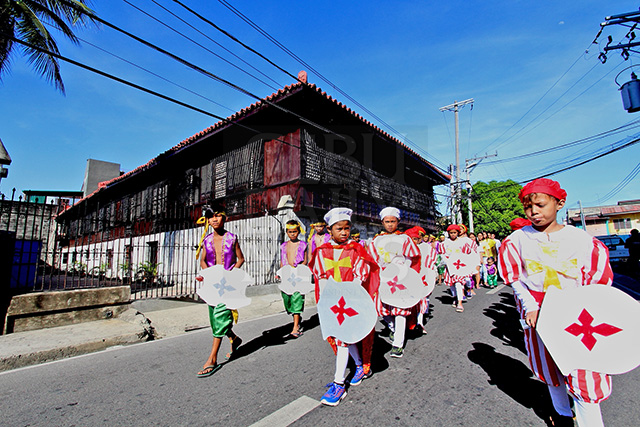Nang Titang’s Sinu’g lives on

Children from barangay Mabolo perform the original Sinulog dance prayer called “Sinu’g” in front of the Casa Gorordo Museum. The Sinu’g is a legacy of Estrelita “Nang Titang” Diola, who led the dance troupe every year until her death in 2014 at the age of 79. (CDN PHOTO/TONEE DESPOJO)
With small wooden swords and shields, a neighborhood dance troupe of 30 boys and girls from barangay Mabolo paid homage to the Sto. Niño.
They danced to the beat of live drums, continuing a Cebuano tradition of the “sinu’g” passed down through generations in the historic Parian district of Cebu City.
Three years after the passing of 79-year-old Estrelita “Nang Titang” Diola, the “keeper of the sinu’g beat”, the original prayer dance lives on.
The “Sinu’g sa Casa Gorordo”, an annual tradition of the Gorordo family, unfolded at 3 p.m. outside the office of the Eduardo Aboitiz Development Studies Center along Lopez Jaena St.
The ritual dance was performed by the Turang Dance Troupe of barangay Mabolo, where Nang Titang lived until her death in 2014. The youths danced in front of a table altar before the image of the Sto. Niño.
Nang Titang’s grand son, Rommel, led the beat using her original goatskin drum.
The choreography and rhythm are different from the popular Sinulog street dance most people see in Cebu’s annual Sinulog parade.
The children dressed as Spanish soldiers and island natives, including a 9-year-old “Sto. Niño”. The dance drama showed the coming of Christianity to the Philippines by portraying the conflict between “moros” and conquistadores as well as the eventual peace between the two forces through the intercession of the Sto.Niño.
Nang Titang’s 64-year-old niece Carolina Diola, who continues to teach the dance steps to Mabolo children, vowed to carry on the tradition. Her challenge is to find a younger successor.
“I’m already old. I am asking Inday Titang and Señor Sto. Niño to help me find the right person who will continue the tradition,” Diola said in Cebuano.
Her 2-year-old grandson joined the ritual dance yesterday along with his mother, Rosemarie Ramirez.
Some of Carol’s grandchildren, wearing T-shirts with the image of “Nang Titang” also joined.
Rosemarie said she wanted her son to join the Sinu’g every year and that when he reaches the age of four, he would play the role of the “child king”.
Yesterday, 9-year-old RJ delos Santos, wearing a red and gold cape, was the Sto. Niño. He was 5 years old when he first joined the Sinu’g.
In the Sinulog grand parade, seen by thousands of tourists and locals, a “reyna” or queen sways with an icon of Sto. Niño in her arms.
However in the “sinu’g”, as taught to Nang Titang by her father when she was 7 years old, there is no dancing queen.
The image of the Holy Child is placed on an altar facing the dancers, who offer vocal prayers in a mix of Latin and Cebuano for the souls of departed loved ones.
Guests yesterday were asked to write the names of loved ones to be read aloud and included in the prayers.
Josefa Gorordo Revilles, an 80-year-old member of the Gorordo family, makes it a point to attend the annual Sinu’g at Casa Gorordo.
She said she was thankful to the Aboitiz family for making the Sinu’g a “house tradition” of Casa Gorordo museum, a 16th century residence of the Gorordo family acquired by the Ramon Aboitiz Foundation.
The Sto. Niño icon placed on a table in front of the young dancers was bought from Madrid by elder aunts in 1950.
Revilles worried that the antique was too delicate for public exposure.
“Dili unta ipagawas. Karon nagkurog-kurog na,” she said. (It shouldn’t be brought outside. See, it’s being shaken.)
For the past two years, the Sinu’g dance has been staged in the concrete driveway for the RAFI headquarters instead of the lawn of Casa Gorordo, which has been closed for renovation since September 2014.
According to Rene Martel of RAFI, they target to finish the renovations and reopen in May.
Casa Gorordo Museum showcases 19th century Cebuano Filipino lifestyle. Four generations of the Gorordo family have lived there, including Bishop Juan Gorordo, the first Cebuano bishop. It was declared a National Historical Landmark in 1991.
Disclaimer: The comments uploaded on this site do not necessarily represent or reflect the views of management and owner of Cebudailynews. We reserve the right to exclude comments that we deem to be inconsistent with our editorial standards.
